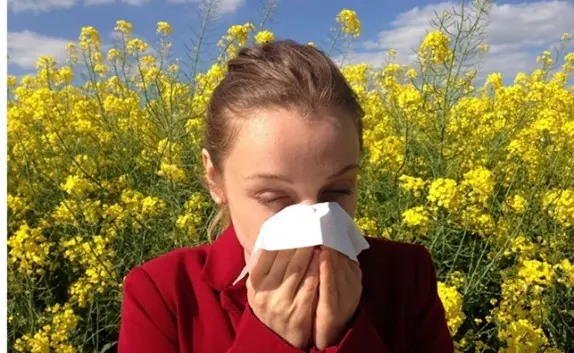
https://jardinage.lemonde.fr/images/dossiers/2017-04/allergie-223727.jpg
Hay fever - a seasonal allergic reaction:
Hay fever is also known as seasonal allergic rhinitis, it is an inflammatory allergic reaction that occurs in response to exposure to allergens in the air, such as pollen from certain flowers or plants . This allergic reaction is often triggered by the release of pollen from trees, grasses and flowers..
When allergens are inhaled, the immune system of sensitive people overreacts, triggering the release of inflammatory chemicals such as histamine. This inflammatory response leads to characteristic symptoms of hay fever:
- Sneezing
-Runny nose
- Nasal itching
- Nasal congestion
- Red, watery eyes
- Breathing difficulties
- Cough
- Etc.
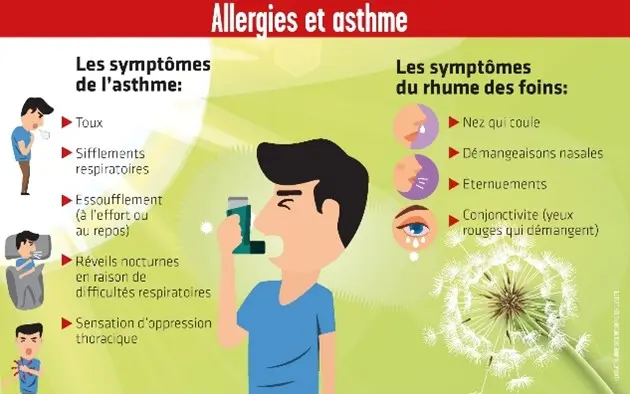
The severity of symptoms can vary depending on a variety of factors, including the type and concentration of pollen in the air, individual sensitivity to allergens, and other environmental and genetic factors. Stress and anxiety are also factors that can exacerbate allergies. Some people may also exhibit similar symptoms when exposed to other allergens, such as dust mites, dust, mold. , with animal hair,…

https://www.lespassionsdepapybougnat.net
The diagnosis of hay fever is generally based on the patient's medical history, as well as an assessment of symptoms and possibly following blood or skin allergy tests to identify the specific allergens responsible for these allergic reactions..
Traditional allopathic treatment generally relies on symptom management, including the prescription of antihistamines, decongestants, or even nasal corticosteroids and other medications to relieve this inflammation..
Preparing before the season:
In order to anticipate the symptoms of hay fever, it is advisable to take preventive measures before they appear. Consumption of hydrosol is strongly recommended and is often effective in alleviating these symptoms. In addition, it is interesting to note that aromatherapy and hydrotherapy have been shown to gradually weaken symptoms from one year to the next, even leading to their complete disappearance..
As a reminder, a hydrosol is an aromatic water obtained during the distillation of the plant with steam in the still. This process allows the essential oil to be harvested; upon cooling, the water vapor becomes liquid and separates, the molecules concentrated on the surface are the essential oil and the remaining water (the distillate) is the hydrosol. The water thus collected contains aromatic molecules in smaller quantities, which nevertheless gives it interesting and gentler properties than essential oils which contain a very high concentration of molecules. The advantage is that there are no contraindications and the hydrosols can be used by children and pregnant women..
Among the most suitable hydrosols against hay fever, we have selected Green Myrtle hydrosol in Cinéole for its anti-infectious, mucolytic and fluidifying properties. It is recommended for clearing the respiratory tract at the first symptoms of a cold and /or rhinitis.
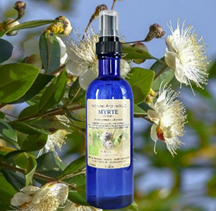
Inule Odorante hydrosol has fluidifying, mucolytic and expectorant properties which allow the entire respiratory tract to be cleared, whether in cases of bronchitis, colds, sinusitis and even coughs.

Orange Flower hydrosol is also worth remembering for its emotional side, it promotes relaxation, relaxation, sleep and acts against stress.
Roman Chamomile or Cornflower hydrosol helps soothe irritated, swollen or red eyes.
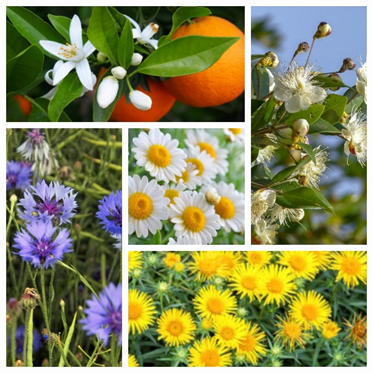
Essential oils :
Using essential oils is a wise method for treating this problem because they contain specific properties that can help alleviate the various symptoms associated with hay fever.
- Essential oil no. 1 is Tarragon (Artemisia dracunculus), known for its anti-allergic and respiratory properties thanks to the Estragole (methyl-chavicol) molecule predominant in this essential oil and the Methyl-Eugenol molecule. which also contributes with its antiseptic and analgesic side. Estragona essential oil may help relieve hay fever symptoms by blocking the release of histamine and dampening the allergic response.
- The essential oil of Roman Chamomile (Anthemis nobilis) is also interesting to promote for its anti-inflammatory and soothing properties. It can relieve itching and irritation of the nasal mucous membranes thanks to the Esters it contains, it is also antihistamine which helps calm itching linked to pollen allergies.

- Radiated Eucalyptus essential oil (Eucalyptus radiata) is a good decongestant to relieve rhinitis, it also has anti-inflammatory properties.
- The essential oil of Scots Pine (Pinus sylvestris) also acts as a general anti-inflammatory which supports the adrenal gland and slows down the hypersecretion of the mucous membranes because its molecules are cortison-like.
Other essential oils have very interesting properties for creating a synergy, such as the essential oil of Annual Tansy (Tanacetum annuum L.) or Camomile Chamomile (Matricaria chamomilla L.), rich in the Chamaeulene molecule which makes it a powerful anti -histamine, anti-allergic and anti-inflammatory. The particularity of these two oils is its blue color.
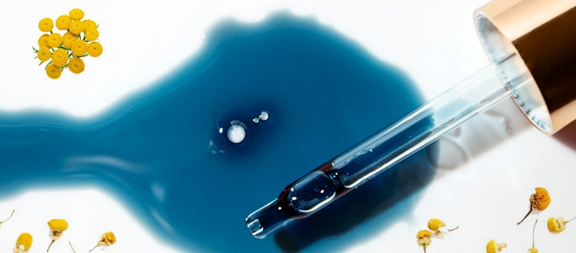
As for vegetable oils:
Nigella (Nigella) is also called Black Cumin, has recognized curative virtues for problems related to the respiratory, digestive and immune systems. Studies have shown that its composition has a positive influence on immunity because it stimulates the production of white blood cells, essential in the body's defense against infections.
The use of Nigella vegetable oil has significant effects on the symptoms of hay fever (stuffy nose, sneezing); it appears that Nigella has anti-allergic properties by modulating the immune response.
In practice :
How to use the benefits of aromatherapy to relieve symptoms? Several methods of administration are possible, whether ingestion, through the skin (massage) or by inhalation (stick, steam inhalation, etc.).
Do not hesitate to ask for personalized advice in order to consider the most suitable solution.
*All products are available for purchase online or to order: by telephone, by email or by message.
Some essential oils have contraindications and it is important to take note of the precautions for use..
The information provided in this article is based on scientific literature and the experience acquired over the years in the various training courses. However, they are provided for information purposes only and should in no way replace ongoing medical care or treatment.
Bibliographic and scientific sources:
BOSSON, L. (2021). “Healing with aromatherapy, energetic practice of essential oils and hydrosols”. Ed. Usha Sàrl, Spain.
GEA, A. (2022). « Physiologie et huiles essentielles, comment les huiles essentielles agissent sur les différents systèmes de l’organisme ». Ed. Dunod. Malakoff.
STAUB, H. and BAYER, L. (2013). “In-depth treatise on Phyto-Aromatherapy”. Ed. Grancher. Paris
L'Atelier MARCATI




Hay fever and aromatherapy: a natural approach to relieving symptoms